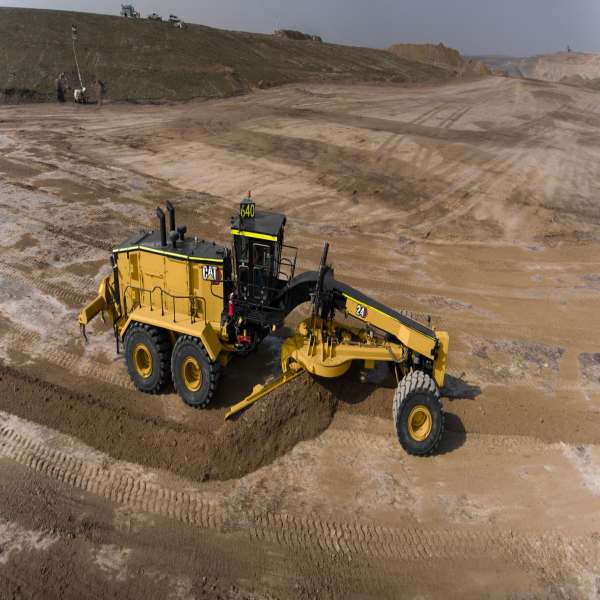As the core power transmission component, the hydraulic system of Caterpillar graders/Niveleuse Carter/Motoniveladora Carte is characterized by high precision and high efficiency, but it is prone to failure under harsh working conditions.
1. Common fault types and cause analysis
Types de défauts courants et analyse des causes
Tipos de fallas comunes y análisis de causas
(1). **Insufficient or fluctuating hydraulic system pressure**
- **Symptoms**: Slow movements, weakness, or unstable pressure gauge display.
- **reason**:
- Hydraulic oil contamination or aging (75% of failures are caused by hydraulic oil contamination);
- The overflow valve is clogged or the spring is damaged, the hydraulic pump is worn (such as internal leakage of the gear pump);
- The oil filter is clogged or the oil suction port is not sealed tightly.
(2). **Abnormal hydraulic oil temperature**
- **High temperature performance**: oil viscosity decreases, seals age, and lubrication fails; **Low temperature performance**: system response is sluggish.
- **reason**:
- Oil radiator failure (e.g. water-cooled radiator leakage causing water to mix with the oil);
- Long-term overload operation or insufficient heat dissipation in the hydraulic system design.
(3). **Travel or turn failure**
- **Symptom**: The grader veers off course, has difficulty walking, or is unable to travel.
- **reason**:
- The pressure of the left and right hydraulic pumps is uneven or the travel motor is faulty;
- The charge pressure is too low (e.g. the charge pump is damaged) or water has entered the transmission fluid, causing wear on the friction plate.
(4). **Frequent damage to hydraulic pump oil seal**
- **Performance**: The oil seal broke several times and hydraulic oil leaked into the travel tank.
- **reason**:
- Wrong selection of hydraulic pump (left-hand/right-hand pump installation direction is wrong);
- The seal ring is aged or the system pressure is abnormal (such as pump blocking).
(5) Oil leakage and component sticking
- **Symptoms**: Pipeline joints leaking, valve core stuck.
- **reason**:
- “O” ring is aging or the joint is loose;
- Oil contamination causes valve port blockage or damping hole sticking.
2. Maintenance methods and technical points**
Métodos de mantenimiento y puntos técnicos
(1). **Fault diagnosis process**
- **Basic inspection**: Use a pressure gauge (0-60MPa) to detect the oil replenishment pressure, system main pressure and actuator pressure to determine the fault point.
- **Code Analysis**: Use the Carter Intelligent Diagnostic System to read fault codes (such as E16 for proportional valve short circuit).
- **Replacement method**: Replace suspected faulty components (such as overflow valves, sensors) to quickly locate the problem.
(2). **Typical fault repair cases**
- **Case 1: Unable to drive**
- **Steps**:
Measure the oil filling pressure (normal ≥2.5MPa). If it is insufficient, check the oil filling pump or replace the filter element;
If the oil filling is normal, check the travel pump outlet pressure and check for contamination of the DA valve or transmission fluid.
- **Case 2: Oil temperature is too high**
- **Improvement measures**: Convert the water-cooled oil radiator to an air-cooled one to prevent coolant from seeping into the hydraulic system.
(3). **Maintenance of key components**
- **Hydraulic pump**: Check gear wear, calibrate direction of rotation (left/right) and replace seals.
- **Overflow valve**: Clean the valve core and damping hole, and replace the damaged spring.
- **Travel motor**: Check the tightness and valve block function, and adjust the chain tension.
3. Maintenance and preventive measures**
Mantenimiento y medidas preventivas*
(1) **Hydraulic oil management**
- **Selection criteria**: Select viscosity according to the temperature (such as 46# or 68# anti-wear hydraulic oil), and the cleanliness must reach NAS1638 standard level 9.
- **Replacement cycle**: Regularly check the oil contamination and use the external circulation method to completely drain the old oil.
(2) **System cleaning and inspection**
- Replace the filter element (120 mesh and above) regularly to avoid mixing impurities when disassembling the components.
- Check the pipes for tightness to prevent air or moisture from entering the system.
(3). **Temperature and pressure monitoring**
- Control the oil temperature at 60-80℃ to avoid aging of seals due to high temperature.
- Regularly calibrate the pressure of each detection point to prevent long-term abnormal wear.
(4). **Professional support and maintenance**
- Complex faults (such as ECM program errors) require contacting a Carter authorized service provider and using original parts for repair.
- Check the transmission fluid and radiator (especially water-cooled ones) regularly to prevent water from entering.
4. Summary/Resumen
Caterpillar grader(Motoniveladora Carter) hydraulic system failures are mostly caused by oil contamination, component wear or design defects. Maintenance requires pressure testing, fault code analysis and professional equipment calibration, while emphasizing the importance of daily maintenance (such as oil management and heat dissipation optimization). For difficult problems (such as frequent oil seal damage or travel deviation), it is recommended to contact the Caterpillar official service network first to ensure maintenance quality and equipment life.
How to buy Motor Grader maintenance related accessories at CCMIE?
If you need to buy Motor Grader/Niveleuse accessories or a new Motor Grader/Niveleuse , you can contact us. If you need to buy a second-hand Motor Grader/Motoniveladora , you can also contact us. CCMIE provides you with comprehensive Motor Grader/Motoniveladora sales services.
Post time: Mar-21-2025

